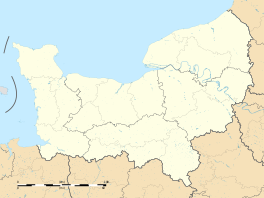Harfleur
| Harfleur | ||
|---|---|---|
 |
||
|
||
| Coordinates: 49°30′26″N 0°11′56″E / 49.5072°N 0.1989°ECoordinates: 49°30′26″N 0°11′56″E / 49.5072°N 0.1989°E | ||
| Country | France | |
| Region | Normandy | |
| Department | Seine-Maritime | |
| Arrondissement | Le Havre | |
| Canton | Gonfreville-l'Orcher | |
| Intercommunality | Le Havre | |
| Government | ||
| • Mayor (2001–2008) | François Guégan | |
| Area1 | 4.21 km2 (1.63 sq mi) | |
| Population (2006)2 | 5,297 | |
| • Density | 1,300/km2 (3,300/sq mi) | |
| Time zone | CET (UTC+1) | |
| • Summer (DST) | CEST (UTC+2) | |
| INSEE/Postal code | 76341 / 76700 | |
| Elevation | 0–89 m (0–292 ft) (avg. 6 m or 20 ft) |
|
|
1 French Land Register data, which excludes lakes, ponds, glaciers > 1 km² (0.386 sq mi or 247 acres) and river estuaries. 2Population without double counting: residents of multiple communes (e.g., students and military personnel) only counted once. |
||
1 French Land Register data, which excludes lakes, ponds, glaciers > 1 km² (0.386 sq mi or 247 acres) and river estuaries.
Harfleur (pronounced: [aʁ.flœʁ]) is a commune in the Seine-Maritime department in the Normandy region of northern France.
It was the principal seaport in north-western France for six centuries, until Le Havre was built about five kilometres (three miles) downstream in the sixteenth century to take advantage of anchorages less prone to siltation. Harfleur is now on the eastern edge of Le Havre's urban area.
A light industrial town situated in the Pays de Caux by the banks of the Seine and Lézarde rivers, some 6 miles (9.7 km) east of Le Havre, at the junction of the N282, D231 and D9015 roads. SNCF railways have a station here.
In Roman times, Harfleur was known as Caracotinum, the principal port of the ancient Calates. A Roman road led from Harfleur to Troyes. Another road that disappeared during the Hundred Years War linked Harfleur to Fécamp.
Several Merovingian sarcophagi have been unearthed at the foot of Mount Cabert.
In the Middle Ages, the town's name, Herosfloth, Harofluet or Hareflot, was still sufficiently uncorrupted to indicate its Norman origins. The suffix fleur comes from Old Norse Flöthe meaning "estuary or arm of the sea" and is related to the word fjord. The precise meaning of the prefix "har" is unknown.
...
Wikipedia



